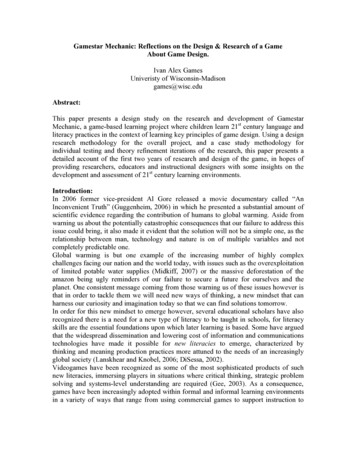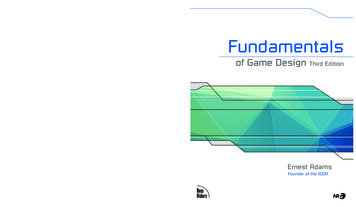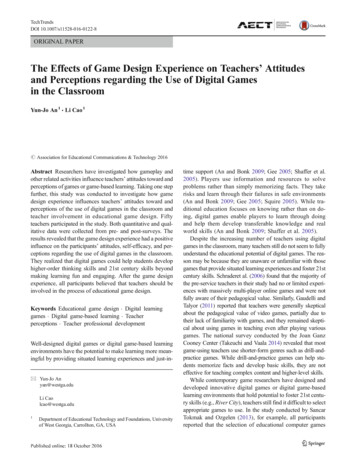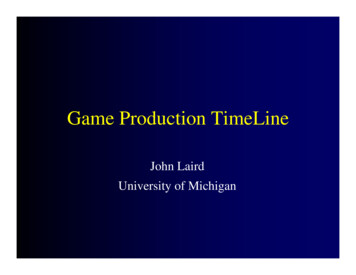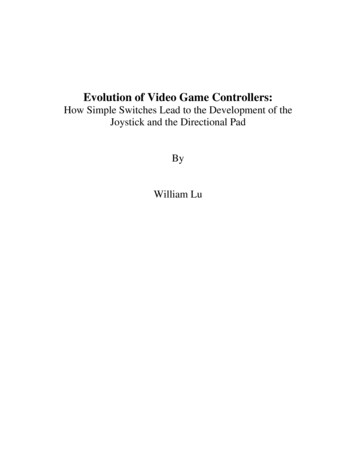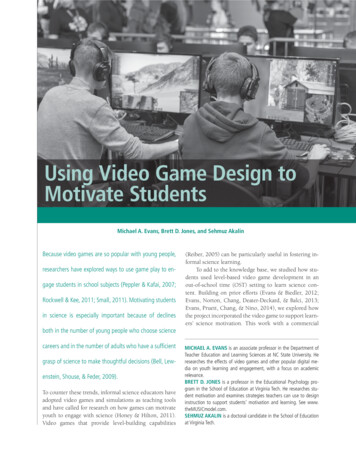
Transcription
Using Video Game Design toMotivate StudentsMichael A. Evans, Brett D. Jones, and Sehmuz AkalinBecause video games are so popular with young people,researchers have explored ways to use game play to engage students in school subjects (Peppler & Kafai, 2007;Rockwell & Kee, 2011; Small, 2011). Motivating studentsin science is especially important because of declines(Reiber, 2005) can be particularly useful in fostering informal science learning.To add to the knowledge base, we studied how students used level-based video game development in anout-of-school time (OST) setting to learn science content. Building on prior efforts (Evans & Biedler, 2012;Evans, Norton, Chang, Deater-Deckard, & Balci, 2013;Evans, Pruett, Chang, & Nino, 2014), we explored howthe project incorporated the video game to support learners’ science motivation. This work with a commercialboth in the number of young people who choose sciencecareers and in the number of adults who have a sufficientgrasp of science to make thoughtful decisions (Bell, Lewenstein, Shouse, & Feder, 2009).To counter these trends, informal science educators haveadopted video games and simulations as teaching toolsand have called for research on how games can motivateyouth to engage with science (Honey & Hilton, 2011).Video games that provide level-building capabilitiesMICHAEL A. EVANS is an associate professor in the Department ofTeacher Education and Learning Sciences at NC State University. Heresearches the effects of video games and other popular digital media on youth learning and engagement, with a focus on academicrelevance.BRETT D. JONES is a professor in the Educational Psychology program in the School of Education at Virginia Tech. He researches student motivation and examines strategies teachers can use to designinstruction to support students’ motivation and learning. See www.theMUSICmodel.com.SEHMUZ AKALIN is a doctoral candidate in the School of Educationat Virginia Tech.
off-the-shelf video game is an example of how a learnercentered, technology-infused approach can advance thetheory and practice of informal science learning (Honey& Hilton, 2011).lishing their own goals and monitoring their own progress with minimal, yet supportive, guidance. We anticipated that this project would motivate students to learnscience and participate in science-related activities.The Mission Evolution ProjectMotivation FrameworksMission Evolution was designed as an afterschool partThe design and study of Mission Evolution were guidednership between investigators at a large research univerby the principles of the MUSIC Model of Motivationsity and staff at a nearby high school in rural southwest(Jones, 2009, 2015). We chose the MUSIC model beVirginia. Students collaborated with their science teachercause it applies current motivation research and theoriesand university instructional and video game design exto educational settings and provides a means to assess theperts to play Spore Galactic Adventures (SGA).effect of instruction on students’ motivation. The MUSICSGA, an expansion pack of the video game Spore, model consists of five key components: eMpowerment,was selected for this project because it allows students notUsefulness, Success, Interest, and Caring. Research cononly to play the game but also to design their own game levsistently demonstrates that, to engage students in learnels. In its simplest form, a game level, or mission, comprisesing, instructors must ensure that students:a start state, an end state or goal, and obstacles presented as1. Feel empowered to make decisions about some aspectsa series of acts that prevent players from reaching the goal.of their learningUsing the level builder, players can design a mission that2. Understand why what they are learning is useful forhas up to eight acts, in which the “captain” (or protagotheir short- or long-term goalsnist) and crew members encounter challenges that may3. Believe that they can succeed if they put forth the effortrequire socializing with or fighting against up to 10 speciesrequiredof antagonists. Antagonists can be generated by the player4. Are interested in the content and instructional activitiesor downloaded from Sporepedia, an online warehouse of5. Believe that the instructor and others in the learningcharacters and items such as dwellings and weapons. Playenvironment care about their learning and about themers can select features such as dialogue, physical appearas individuals (Jones, 2009)ance, atmosphere, protagonists, rewards, and music.The purpose of using SGA in Mission Evolution wasEach of these components has been shown to predict stuto teach students specific concepts of evolutionary biology,dents’ motivation and engagement (Jones, 2009, 2015).such as speciation (the evolutionary process that resultsTo examine the effects of Mission Evolution on stuin new species), mutation, adaptation, extinction, anddent motivation, we also used the three genres of parnatural selection. This objective aligned with the Virginiaticipation identified by Ito et al. (2009): hanging out,learning standards of the students’messing around, and geeking out.school biology curriculum. AnotherThese categories capture the waysobjective was to teach students toyouth appropriate digital mediaThe design and study ofuse sound game design principles,and technologies, notably videoMission Evolution weresuch as giving players goals that aregames, to socialize, interact, andguided by the principles of learn. Hanging out is a genre ofdifficult yet achievable. The projectthe MUSIC Model ofthus challenged students to createparticipation in which technologygames that were both scientificallyMotivation (Jones, 2009, serves merely as a social lubricantaccurate and fun to play. When theto bring like-minded youth to2015). We chose thestudents had finished their games,gether. Messing around characterMUSICmodelbecauseitthe science teacher rated the games’izes youth who approach digitalapplies current motivation media with a purpose and growingscientific aspects, and the universityvideo game experts rated the designshared interest. In the final phaseresearch and theories toaspects.of development, geeking out, youtheducational settings andMission Evolution engageddemonstrate a degree of expertiseprovides a means to assess that, though it often goes unrecogstudents in a self-regulated environment. Students had creative the effect of instruction on nized in school settings, providescontrol over their learning, estaba sense of self and increased confistudents’ motivation.Evans, Jones, & AkalinUSING VIDEO GAME DESIGN TO MOTIVATE STUDENTS19
dence, which in turn can lead to interest-driven learning. Although Ito andcolleagues (2009) provide rich descriptions of hobby-based use of digital media, additional evidence of purposefuluses for school- and career-related topics would contribute to the literature.MethodPhases of Mission EvolutionMission Evolution was staged in threedistinct phases that followed the semester schedules of the high school. InPhase 1 (spring), the video game expertsconducted a series of three afterschoolmeetings with the students and teacherthat provided a quick-and-dirty introduction to SGA. These meetings gavestudents the knowledge and skills theyneeded to succeed in the next phases;success is one of the components of theMUSIC model.In Phase 2 (fall), students playedthe Cell and Creature stages of Spore instructured afterschool workshops. This Figure 1. A student uses a storyboard template, adopted fromindustry practice, to sketch out her game about speciation, titledpractice helped students understandStrangely Familiar.how evolution was treated in the gamewhile becoming familiar with the Sporeworld, characters, and mechanics. This phase incorpoactivity was useful because it helped students learn morerated most components of the MUSIC model: It proabout biology, taught them science and technology skillsmoted empowerment by providing students with somethat could be relevant to future goals, and enabled themchoices and fostered caring in a supportive environmentto help other students learn biology by playing the gamesthat allowed students to succeed at building their skills inMission Evolution students had designed.an interesting activity.In Phase 3, eight 10th- and 11th-grade students parFinally, in Phase 3 (the following spring), studentsticipated in afterschool workshops in their science classdesigned, built, and tested their games. Students experoom once or twice a week for eight weeks. Workshopsrienced more empowerment in the form of choices andvaried in length from 60 to 90 minutes, and participationdecision-making ability. They successfully worked on anwas voluntary. In the workshops, the students designedinteresting activity in a caring environment. Finally, theand developed games based on a scientific concept theyTable 1. Sample Games Produced by Students in Mission EvolutionGAME TITLEDESCRIPTIONDown the Rabbit Hole 1and 2How DNA mutations help a species develop camouflage abilities toincrease species fitnessApocalypseSurvival of the fittest members of a species; how mate selectionbased on genetic variation can strengthen the species over timeThe Chita-TángaHow migration can necessitate adaptation to enable species members to survive and reproduce20Afterschool Matters, 26 Fall 2017
Table 2. Interview Questions and MUSIC ComponentsMUSIC COMPONENTINTERVIEW QUESTIONEmpowermentHow much control do you have over what you’re working on?What things do you have control over?UsefulnessHow useful is this activity for your goals this year or in the future?In what ways is it useful?SuccessHow successful do you think that you will be at this activity?Why will you be successful?InterestHow interested are you in working on this activity?How much do you enjoy this activity?What about it interests you?How important is this activity to you?Why is it important?Caring (teacher)How much does your teacher want you to succeed at this activity?How much does your teacher like to help you on this activity?How do you know?How much does your teacher care about you? How do you know?Caring (students)How much do other students want you to succeed at this activity?How do you know?How much do other students care about you? How do you know?selected themselves, such as DNA mutation, adaptation,competition, and survival. Three of the games are describedin Table 1. The 11 workshops were organized as follows. Sessions 1 and 2: Learn to complete expert logs forSpore analysis Session 3: Learn how to storyboard games, receive therubric to be used to evaluate the games, and thinkabout how playing Spore can contribute to the gamedesign Sessions 4 and 5: Storyboard game designs (see Figure1) and get feedback from the design experts Sessions 6, 7, and 8: Build games in SGA and get moredesign feedback Session 9: Demonstrate games to a “jury” of expertsand receive feedback Session 10: Finalize games and receive final round offeedback Session 11: Celebrate with a partyDuring the sessions, students were supported by theschool science teacher, a graduate student in computerscience who helped with game design and technical issues, and a graduate student in science education whohelped to verify the rigor and accuracy of the scientificconcepts and their treatment in the games. This structure provided scaffolding without directing students tomake specific choices as they designed, developed, andEvans, Jones, & Akalintested their video games. It embodied the MUSIC model,providing students with empowerment in a caring and interesting environment that supported their success in anendeavor that at least some students found useful.Research Design and Data CollectionFollowing a design-based research approach (Brown,1992; Edelson, 2002; Lamberg & Middleton, 2009), weincorporated participant-observer techniques and periodic semi-structured interviews to investigate how thestudents, supported by their teacher, applied conceptsin evolutionary biology to build their video games. Wetreated this project as a co-design activity involving thescience teacher, her students, and researchers and graduate students from the nearby university.To examine students’ levels of motivation, we interviewed them at three intervals: during sessions 4 and 5,during sessions 7 and 8, and at the end of the project.The interview questions we developed (Table 2) assessedstudents’ perceptions of the components of the MUSICmodel. We recorded the interviews and then transcribedand analyzed the text. We also recorded field notes ofour observations of project sessions and interviewed thescience teacher at the end of the project. We then used allthese data to identify themes.USING VIDEO GAME DESIGN TO MOTIVATE STUDENTS21
Case Studies of Three StudentsWe selected three students as case studies to illustrate howstudents approached Mission Evolution with differingagenda, how the project affected students’ motivation andinterests, and how students’ engagement varied by theirgenre of participation (Ito et al., 2009). Each student’sperceptions are presented in the order of the MUSICmodel components: empowerment, usefulness, success,interest, and caring.JackJack was a 17-year-old White male in 11th grade. Whenasked about his empowerment in the project, Jack reported that he had a lot of control: “We are pretty muchdoing whatever we want along the guidelines and get tocontrol every aspect we can.” He added that he had control over “the look of the game, the actual objects in thegame, and how the game works.”Jack found the project useful for his future goals,particularly because he was interested in game designas a career. He also talked about how what he learnedwould be “really useful for figuring out what I would doin a similar situation like a work environment.”He reported that he was successful in this project:“We have a tangible product because we actually havea game that is playable.” The game provided concretefeedback that allowed him to judge for himself whetherhe was successful. The project also appears to have provided a reasonable level of challenge for him. He said itwas “challenging, but not too difficult.” “The only realdifficulty is trying to figure out how to do what you envision with the technology provided. The technology isgood, but it has constraints such as every [software] program would. Other than that, it’s not hard.”When asked how interested he was in the project,he said, “My favorite thing to do is design.” He added,“Trying to incorporate a learning environment into gamedesign is a really good idea. Really fun to execute, ’causeit’s always fun to create stuff.” These comments reflectJack’s interest in participating in the design aspects of thisproject; it also indicated his longer-term interest in design. In fact, Jack ordered his own copy of the softwareso he could work on it on his own time. After noting that“sometimes I don’t even do my schoolwork on my owntime,” Jack said that he stayed up until 2:00 a.m. workingon his SGA project. “I’ve put in a reasonable amount ofeffort,” he added, “which is sometimes unusual for me.”Jack seemed to feel that the environment wasrelatively caring. He noted that the teacher was helpful,that she wanted him to succeed, and that she made sure22Afterschool Matters, 26 that everything was going smoothly. He also reported thatshe cared about students enough to ask about their wellbeing. When asked whether other students cared abouthis success in the project, he said that he believed that theywanted him to succeed. He did not give the impressionthat he worked closely with any other students, but hedid say that students “bounced ideas off each other.”MiaMia was a 15-year-old White and Native American female in the 10th grade. Mia’s interview responses indicated that she felt empowered in the project: “I have complete control. I have control over what aspects of scienceI put into it, what the plot line is, and the characters.”Mia also found the project useful for her goals: “It’s goingto be a big deal in the future when I try to go for collegeand medical school.”She said that she had been successful: “I’m verysatisfied with my game I have designed and the work Ihave put into the whole project.” She said that the mostchallenging aspect of the project was time management.Mia was interested in the project because it incorporated “both gaming and science, which are two thingsI’m very interested in.” Her interest extended beyond thedesignated project time, perhaps indicating that she hadbegun to develop longer-term interest. She said that theproject had been “really important to me. It’s the onlything I do outside of school.” She felt that she put a greatdeal of effort into the project: “I’ve been to every meetingand I’ve gone extra times during lunch. I skip lunch towork on this project.”Mia said that the teacher cared “quite a bit” aboutthe students, adding that the teacher was always thereto help if something went wrong or if students neededsomething. Mia said that, though there was some competition among students, “I’m sure they don’t want me tofail, or anyone else to fail.” She mentioned that studentswould share praise when something went well, such as“Whoa, that’s pretty good!”WalterWalter was a 15-year-old African-American male in 10thgrade. Walter said that he was somewhat empowered during the project. When asked how much control he had,he responded, “I guess a fair amount. There may besome things you may not be able to do, but things youcan work around to get your desired goal.”The project was useful to him: “I did want to learn abit more of biology this year . As a project, it did help;it taught me a few side things along the way. In the fu-Fall 2017
ture, I’ll probably be able to incorporate what I learned indifferent situations and future education.”Walter said he felt successful in the project: “We didfinally each create a game. That was our priority andour goal.” His success seemed to be tied to his ability tomeet the challenges of the project, which also led to increased interest: “I wasn’t too interested in the beginning.I wasn’t really sure exactly what we would be doing. Aswe progressed, it was more and more challenging. Yeah,I was more interested in it.” Although Walter did not findthe project to be very important to him, he could see howit could be important to other people: “It was slightlyimportant because we had set a goal and we planned toreach it . It teaches people and still incorporates gaming, which is important to some people.” Walter missedseveral sessions in February because the workshops conflicted with training for his sports team. Though he wouldstop by the Mission Evolution room before practice to sayhello to students and staff, he did not seem to be investedenough to allow the project to interfere with an activity heapparently found more enjoyable.Walter felt a special appreciation for his teacher’scaring: “I think she’s very dedicated to [the project]. Itwas on her time, not the school’s. She does care a lot.”Walter also felt a strong sense of community in the classroom: “I think [my classmates] want everyone else tosucceed. We’re moving toward the same goal. We’re justtrying to push each other and help each other to get therefaster and more effectively.”Observations of Students’ ParticipationOur program observations suggest that Jack, Mia, andWalter approached this project with varying agenda.Jack, an adept 11th-grader who had participated in earlierworkshops, used his graphic arts skills and knowledgeof video games to develop a sophisticated product thatbalanced science knowledge with game mechanics. In anexample of the genre of participation Ito et al. (2009)call geeking out, Jack used his time during the workshopsto help others overcome obstacles to make their storyboards work in the game medium.Mia, by contrast, was quiet and reserved, yet artistically talented; she dedicated most of her workshop timeto game design and development. Her preferred modeof work was to sit at the edge of the long workbench,headphones in place, focusing intensely on her game. Wesee this behavior not as isolation, but as a quest for excellence on the part of an intensely engaged student. In asense, Mia struck a balance between messing around andgeeking out (Ito et al., 2009).Evans, Jones, & AkalinFinally, Walter approached the project mostly as asocial gathering, spending equal amounts of time working on his game design and chatting with classmates.His demeanor indicated that he did not take the experience very seriously. Despite missing several sessions inthe spring, Walter completed his game, a technically andartistically sophisticated treatment that dealt with the science in a rigorous way. In terms of the genres of participation, Walter seemed to slide effortlessly from hangingout to messing around and occasionally to geeking out.Students’ Motivation and EngagementThese case studies show how students can participatein the same project but engage with it at different levelsdepending upon their abilities, personalities, and goals.All three students reported that the project empowered them by giving them choices. Two specific aspects of Mission Evolution were designed to encouragethis sense of empowerment. First, the structure of theinformal learning setting allowed students to choose aconcept from the high school evolutionary biology curriculum and decide how to implement it in their gamedesigns, supported by the science teacher and the university video game experts. Second, the way the gametechnology was implemented provided choices, but withsome structured guidance. For example, students beganby playing the Cell and Creature stages of SGA, whoseconcepts related to concepts from their biology class.Then they worked with SGA tools and tutorials that wereintuitive enough to use with minimal support. Beforestudents started their own game designs, the expertsprovided a worked example to show how the concept ofdivergence could be illustrated in game play.Although all three students reported that the project was useful, it appeared to be more useful to Jack andMia than to Walter. Jack and Mia both suggested thattheir learning could be helpful in their careers. This perceived usefulness probably motivated them to engage inthe project. For Walter, the project was somewhat useful for learning biology, but he did not relate this newknowledge to his personal goals. This lack of connectionto future usefulness may be one reason he seemed lessengaged in the project than Jack and Mia were.All three students said that they were challenged bythe project in a way they enjoyed because, ultimately,they succeeded in meeting the challenges. Facing andovercoming obstacles seemed to be a motivating experience for all of them. This finding suggests that the projectpresented an appropriate level of difficulty—neither soeasy that they were bored nor so hard that they gave upUSING VIDEO GAME DESIGN TO MOTIVATE STUDENTS23
before they could succeed. All participants were familiarOur first recommendation is to select a game and trywith basic game interfaces and mechanics, but even playit yourself. (See the box on the next page to get started.)ing the Cell and Creature stages of SGA presented a chalAssess what students can learn from the game and howlenge because there wasn’t enoughdifficult it is. A game that is tootime to both learn the game anddifficult or too easy will not fullycomplete the stages during workengage students. Consider whetherTheprojectinterestedallshops. The experts helped withthe objectives are appropriate andthree students, but inthis challenge by introducing theare correlated with the objectivesstages in a way that gave studentsof the school curriculum, if suchdifferent ways. Jack wasa running start. Once studentsalignment is important to yourinterested in the designmoved from game play to learningprogram.aspects, Mia in the gamingSGA game mechanics so they couldSecond, think about the fiveand science aspects, and components of the MUSIC modelimplement their own designs, theyencountered more challenges.as you select a motivating and enWalter in the challengesAgain, the experts were there toand the final product. One gaging game. Does the game givehelp; some students, like Jack andstudents control over level design?strength of the project isMia, had enough invested in overCan the content and design prothat its multiple facetscoming the challenges to spendcess be useful toward students’coulddrawinstudentstheir own time on the project.personal goals? Will game designThe project interested all threeprovide an appropriate level ofwith diverse interests.students, but in different ways.challenge while allowing studentsJack was interested in the designto succeed? Is the process interestaspects, Mia in the gaming and sciing and enjoyable? Does the gameence aspects, and Walter in the challenges and the finalallow for some type of caring relationships with others?product. One strength of the project is that its multipleOf course, you must determine whether your profacets could draw in students with diverse interests. Angram can supply the software and hardware neededimportant finding is that Walter became more interestedfor the game. You must also think about the skills reover time. His interest in overcoming the challenges ofquired—both content knowledge and technical skills.game design was key to his engagement, given that heHave the students learned the subject matter in school?did not believe the project would be useful to his future.Will you need to teach or review the content to ensureThe work that Jack and Mia put into the project outsidethat all students have the knowledge needed to play theof the workshops shows that they were more interestedgame? What about technical skills? A good way to asand found more value in the project. This interest andsess both the content and technology skills needed is tovalue is important because researchers (Hidi & Renhave a couple of students play the game and report anyninger, 2006; Jones, Ruff, & Osborne, 2015) contendproblems. If students are going to need technology help,that, when students value activities, they are more likelydo the program staff have the capability to support them?to engage in similar activities in the future.If not, you can invite partners to join the project: teachIn terms of caring, students said the learning enviers, parents, university students, community members—ronment was a friendly one in which students got alongeven more knowledgeable students. Anticipate the proband helped each other when they could. All three stulems that students or staff might encounter and preparedents said that they felt strongly supported and cared forto address them as best you can.by the science teacher. This support, coupled with theTo help students move from game play to game decongenial peer environment, may have contributed tosign, a first step is to choose a game with a level editor.students’ motivation.We selected SGA for our project because the expansionpack added a level editor to the Spore game. Level editorsRecommendations and Conclusionsgive students a development environment in which toFindings from our project design, observations, and casedesign their games. Perhaps more importantly, we alsostudies lead us to recommendations to help programprovided instruction on what constitutes “a game,” usingleaders who want to use students’ interest in video gamesmaterials provided by the game producer, as well as temto build science motivation and engagement.plates derived from game design resources. One of the24Afterschool Matters, 26 Fall 2017
VIDEO GAMES THAT INCLUDEDESIGN ASPECTSHere are some games, as of May 2017, that bothhave educational value and allow users to designnew levels or missions. Civilization: https://www.civilization.com Gamestar Mechanic: https://gamestarmechanic.com/teachers LittleBigPlanet: http://littlebigplanet.com Minecraft Education Edition: https://education.minecraft.net Roblox: https://www.roblox.comYou can find more options by searching online.Try adding the phrase “user-generated content”to ensure that the games include designcapabilities.most approachable resources we used was Jesse Schell’s(2014) The Art of Game Design: A Book of Lenses.To increase students’ engagement, you may wantto design sessions to allow students to hang out, messaround, and geek out. Like our case study participants,students may seek different ways to participate in gamedesign. The genres of participation allowed us to appreciate these differences. Although the OST program didneed to abide by the school’s timeline restrictions, students were free to hang out, mess around, or geek outduring certain portions of each session. We saw hangingout as a legitimate genre of participation that providedvalue to the experience, rather than being off-task behavior. Each genre has a function that contributes to learningunder the right circumstances.As with any learning activity, identifying specificgoals is crucial. It may be fine to let students simply playaround and learn whatever they learn. If you have specific learning objectives, you should articulate these objectives to students and develop assessments that providefeedback about their progress. For example, students canshare their work with facilitators or peers at certain milestones or can meet with facilitators on a regular basis.Regular feedback, provided in a caring environment, willkeep students focused on their goals—whether playingaround or meeting specific curriculum objectives.Students’ experiences in Mission Evolution suggestthat commercial video games, particularly those that provide level-building capabilities, can help OST programsEvans, Jones, & Akalinmotivate students to engage in science content. Viewingthe project through the lens of the MUSIC model andgenres of participation helped us to understand some of th
the project incorporated the video game to support learn - ers' science motivation. This work with a commercial Michael A. Evans, Brett D. Jones, and Sehmuz Akalin Using Video Game Design to Motivate Students MICHAEL A. EVANS is an associate professor in the Department of Teacher Education and Learning Sciences at NC State University. He

